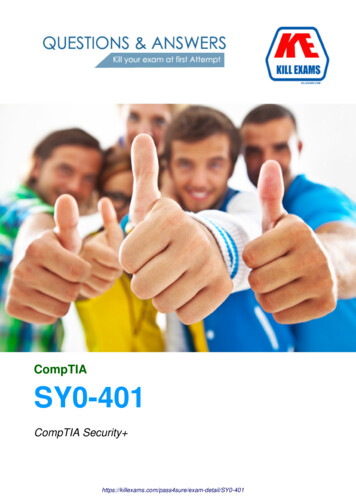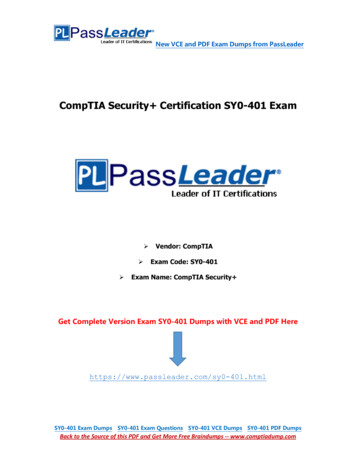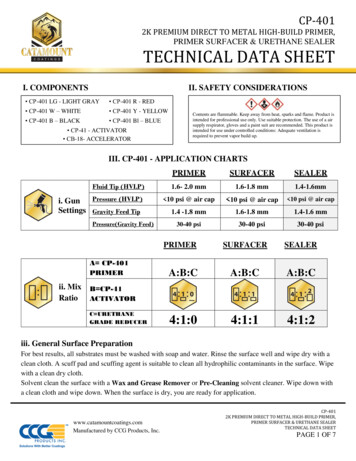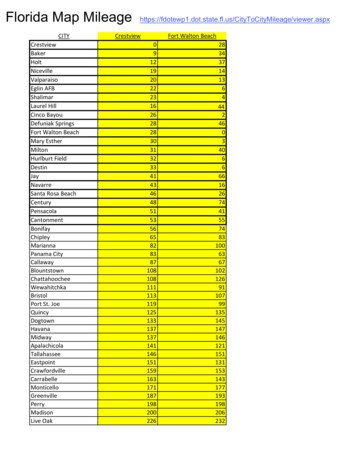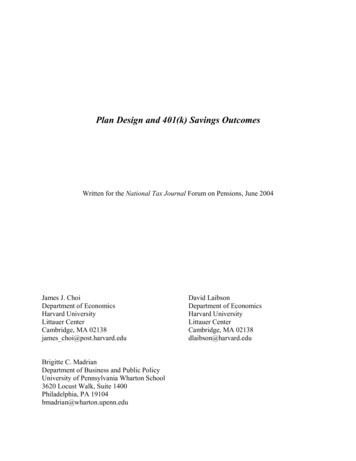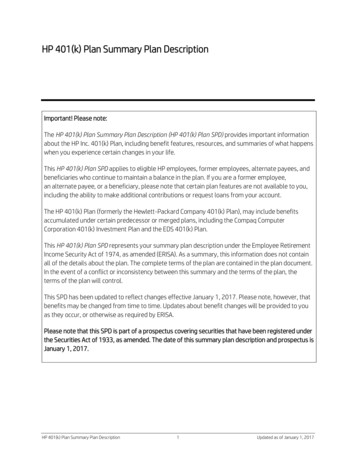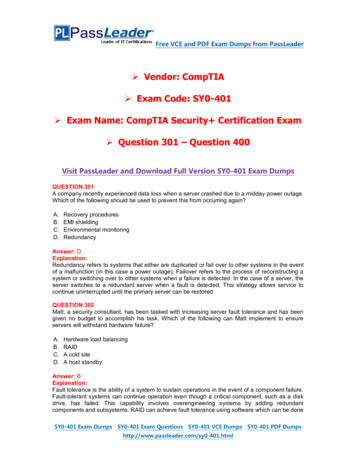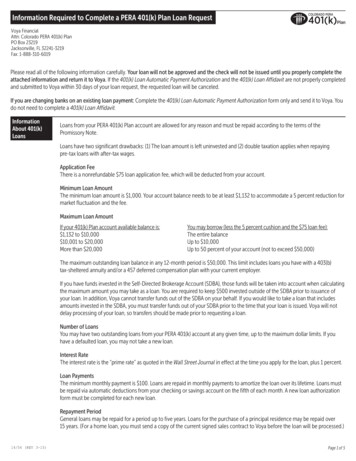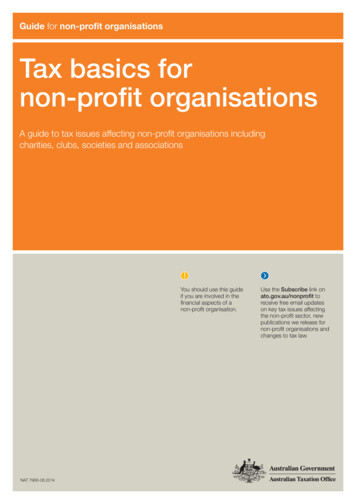
Transcription
UNDERSTANDING 401(K) ANDPROFIT SHARING PLANSChoosing an option that benefits yourbusiness and your employees.
UNDERSTANDING 401(K) AND PROFIT SHARING PLANSAs a business owner, you’re likely concerned about retirement, for yourself and youremployees. Often, the issue isn’t whether to implement a retirement plan but how to choosethe one that will work best. This brochure is designed to help you decide which profit sharingplan is right for your business by comparing the most popular types available, including: Traditional profit sharing plans Age-weighted and new comparability profit sharing plans 401(k) plans and structuresPROFIT SHARING PLANSProfit sharing plans offer employers both design flexibility and discretion with regard tocontributions. Employer contributions are self-determined and can be allocated in a numberWORKERS TODAYof ways. If an employer makes little or no profit during a year, no contribution is required,EXPECT ADDEDalthough an employer is permitted to make contributions even if the company is not profitable.BENEFITS.An employer’s maximum deduction is limited to 25% of the annual compensation paidto eligible employees. For 2016, the individual maximum contribution limit for employeesapplied to all defined contribution plans is 100% of compensation or 53,000, whichever isless. Depending on a profit sharing plan’s allocation formula, the contributions for individualemployees may exceed the 25% level as long as the aggregated employer contribution doesnot exceed the 25% maximum employer contribution limit.There are three basic types of profit sharing plans: traditional, age-weighted and newcomparability. The differences between the plans are the contribution allocation formulasused for each one. The following sections discuss the three types of plans.TRADITIONAL PROFIT SHARING PLANA traditional profit sharing plan follows the salary ratio method, which is designed toallocate employer contributions to all participants on a uniform basis. For example, if oneemployee receives a 10%-of-pay contribution, all eligible employees would be allocated 10%of compensation as their share of the contribution. A profit sharing plan with a salary ratioformula is similar to a simplified employee pension (SEP) plan, but may be more attractivethan a SEP plan in situations where an employer (a) does not wish to cover certain part-timeemployees, (b) wants to make employer contributions subject to a vesting schedule or (c)wants more control over the assets.1
2
UNDERSTANDING 401(K) AND PROFIT SHARING PLANSAGE-WEIGHTEDThe age-weighted method allocates contributions based on both the age andcompensation of eligible employees. It is similar to a defined benefit pensionplan, but gives employers the option of making discretionary contributions.Since a participant’s age or length of time until retirement is factored intothe allocation formula, older participants receive a proportionately largershare of the contribution. This can be advantageous in situations where acompany’s key employees are significantly older than its other employees.Although this type of plan is available to any size company, age-weightedplans are designed to be top heavy and are especially well-suited for smallbusinesses and professional practices.With an age-weighted plan, some employees receiving equal compensationcould receive different profit sharing allocations, based on age. In addition, anolder non-principal employee may receive a larger share than a younger principal.THE ISSUE ISN’T WHETHERTO IMPLEMENT ARETIREMENT PLAN BUTNEW COMPARABILITYThe new comparability, or cross-tested, allocation method allows anHOW TO CHOOSE THE ONETHAT’S BEST FOR YOU.employer to divide employees into different classifications for purposes ofallocating contributions. If non-discrimination requirements are met, a largershare of a company’s contribution may be made on behalf of those employeesto whom the employer wishes to provide more significant benefits.As with an age-weighted plan, non-discrimination testing is based onprojected benefits at retirement, similar to a defined benefit plan. If theaggregated age of the favored employee group is higher than the othergroups, the allocation of current dollars can be skewed proportionatelytoward the older group. This type of plan involves complicated calculationsand may require actuarial consulting, but it is typically less expensive andmore flexible than a defined benefit plan.This plan may be appropriate in a situation where a business wants to favorolder or highly paid participants. These plans may establish several “class”designations of employees, such as placing principals in the first group,officers in the second group and all other employees in the third group.3
Eligible EmployeeAgeW-2 CompensationTraditional ProfitSharing PlanSocial cer 157 265,000 26,500 24,400 46,903 29,239Officer 238 265,000 26,500 24,400 9,955 29,239Employee 150 40,000 4,000 5,867 4,000 1,566Employee 235 30,000 3,000 4,400 882 1,174Employee 325 20,000 2,000 2,933 261 783 620,000 62,000 62,000 62,001 62,000TOTALSThis chart is an example of the available allocation methods in a profit sharing plan using a 10% contribution.Eligible EmployeeAgeW-2 CompensationTraditional ProfitSharing PlanSocial cer 157 265,000 53,000 53,000 53,000 53,000Officer 238 265,000 53,000 53,000 27,887 53,000Employee 150 40,000 8,000 6,740 9,999 2,726Employee 235 30,000 6,000 5,055 2,206 2,045Employee 325 20,000 4,000 3,370 650 1,363 620,000 124,000 121,164 93,742 112,134TOTALSThis chart is an example of the available allocation methods in a profit sharing plan designed to maximize contributions for the oldest owner.CONSIDER A 401(K) PLAN FOR YOUR COMPANY,YOUR EMPLOYEES AND YOURSELFYour company’s success depends on quality employees. Attracting and retaining them oftentakes more than a competitive salary or a satisfying environment. Workers today expect addedbenefits including the means to save for retirement through options such as a 401(k) plan.As a business owner, you likely already recognize the importance of offering – and receiving –such a benefit. Establishing a 401(k) plan can provide you and your employees with the means4
UNDERSTANDING 401(K) AND PROFIT SHARING PLANSfor achieving secure retirements, while also helping youAn employer should consider several basic factorsgain tax advantages for your business and ultimatelywhen evaluating whether a 401(k) plan is right for his orbenefiting your company’s bottom line.her company:However, deciding which 401(k) arrangement is best forEligibility requirementsyour organization – and then maintaining the plan – canEmployees who are at least 21 years old and who havebe a challenge. That’s where we can help. Our goal is tocompleted one year of service are generally eligible towork with you to determine the best approach for yourparticipate. Certain employees, such as those coveredbusiness and then identify the plan that best meets yourby a collective bargaining agreement, may be legallycompany’s unique needs. Since Raymond James has noexcluded.proprietary “in-house” 401(k) products, we offer trulyobjective advice. We not only assist in evaluating options, but work withyou on an ongoing basis to coordinate the differentcomponents of the 401(k) process. We believe thatFunding the 401(k) planA 401(k) plan can be funded from one or more of thefollowing sources: All 401(k) plans permit employees tovoluntarily contribute, or “defer,” a portionof their salaries to the plan, as either pretax or after-tax Roth contributions.establishing a 401(k) plan for your company also meanscreating long-term relationships with your employees –helping them understand how to invest and coordinatetheir 401(k) allocations with their other assets to develop The next few pages offer an overview of 401(k) plansand the decisions needed to ensure your company’sprogram is effective.ABOUT 401(K) PLANSemployees to make elective salary deferrals whileavoiding current taxes on that portion of their incomes.Most employers, including not-for-profit organizationsbut excluding government entities, can offer a 401(k)plan to their employees.MATCHING EMPLOYER CONTRIBUTIONTo provide an incentive to participate,many employers match a portion of eachparticipant’s elective salary deferral. Thisdiscretionary matching contribution is taxdeductible for the company. An employermay not make the matching contribution inthe form of an after-tax Roth contribution.complete financial plans.A 401(k) is a profit sharing retirement plan that allowsEMPLOYEE ELECTIVE SALARY DEFERRAL EMPLOYER PROFIT SHARING CONTRIBUTIONEmployers may also make discretionarycontributions to all eligible employees,regardless of whether the employees makeelective salary deferrals. The employerprofit sharing contribution must be pre-taxand not an after-tax Roth contribution.The Economic Growth and Tax Relief Reconciliation Actof 2001 (EGTRRA) allowed employees to add qualifiedRoth contributions to 401(k) plans starting January 1,2006. The Roth 401(k) contributions only apply toemployees’ elective salary deferrals.5
Individual contribution limitsThe maximum 401(k) deferral for 2016 is the lesser ofACTUAL DEFERRAL PERCENTAGE (ADP) TEST100% or 18,000 of each employee’s eligible payroll. Plandocuments may limit salary deferrals to less than 100%.Employer contribution limitsThe employer’s contribution limit is 25% of eachemployee’s eligible payroll. While an employee cancontribute more than 25%, total combined contributionsfrom deferrals, matching employer contributions andemployer profit sharing contributions cannot surpassthe 53,000 maximum.Non-discrimination requirementsThis chart illustrates the highest deferralpercentage available to the HCE group,as an average, if the ADP for the NHCEgroup is at a specific level.HCENHCE2%1%4%2%5%3%Highly compensated employeesinclude:6%4%7%5%1. Employees with 5% or moreownership stake and8%6%9%7%2. Any employee who earns 120,000* or more.10%8%*Indexed figures for 201611.25%9%12.5%10%401(k) plans may not discriminate in favor of highlycompensated employees (HCEs) – employees who own5% or more of the company or who earn a minimumof 120,000. Each plan is subject to an annual nondiscrimination test, commonly referred to as the actualdeferral percentage (ADP) test, which is intended toprevent the plan from benefiting only an HCE group. Inessence, the amount that an HCE may defer is controlledInvestment alternativesMost 401(k) plans enable participants to choose froma variety of investment alternatives. An effective planshould allow employees to move freely among availablefunds to create the best asset allocation for their needs.by the deferral rate of the non-highly compensatedRecordkeepingemployee (NHCE) group.Allocating contributions and earnings among differentIn addition, every 401(k) plan has a number of differentcomponents that must be coordinated to optimizeemployee benefits.investment alternatives, calculating vesting amounts,and generating participant statements are usuallyreferred to as participant level accounting. Thesefunctions are critical to keep the plan running smoothly.Plan administrationRegulatory functions, such as plan qualification,non-discrimination testing, reporting to the IRS anddisclosure to employees, must be performed on anannual basis. In addition, participant-level informationmust be incorporated into plan-level accounting as partof IRS reporting.6
UNDERSTANDING 401(K) AND PROFIT SHARING PLANSEmployee communicationoption and fees are incurred from multiple sources,From the long-range perspective of creating a means forit provides additional flexibility that may be critical toemployees to accumulate retirement assets, effectivemeeting the plan’s objectives.communication is the most important component of the401(k) plan structure. Each employee must have a basicunderstanding of the concepts of investing and how theplans work.UNBUNDLEDIn this arrangement, many components operate independently, and no single source is responsible for the processas a whole. As a consequence, although this option offersTrustee selectiontotal investment flexibility, it has the greatest potentialUnlike in a traditional pension plan, in a participant-for operational breakdowns and poor service. In addition,directed 401(k) plan an outside trustee mainly performsthe unbundled approach may require more day-to-daycustodial functions – such as distributions and the relatedemployer involvement.reporting functions – but assumes no fiduciary liability.While your company’s needs dictate the type ofplan that is most appropriate, the majority of smallSTRUCTURING YOUR PLANbusinesses tend to select the single- or multiple-sourcearrangements to reduce management responsibility,While many factors influence 401(k) decisions, choos-as well as the likelihood of problems coordinating theing a structure is often determined by the maintenancedifferent facets of unbundled plans.and fees involved. The three basic structures are:SINGLE SOURCEThis arrangement is a full-service package that providessingle-source responsibility – as well as a single sourceof fees – for all functions. Frequently referred to as a“bundled” plan, this format has the fewest componentsand is the simplest to maintain.In addition to the general structure of your plan, there arealso two investment arrangements from which to choose:SINGLE MUTUAL FUND FAMILYProviding investment choices from a single companytypically offers the lowest overall cost since all functionsare controlled by one entity. Choosing a fund family withinvestment alternatives across different asset classesMULTIPLE SOURCEcan deliver a cost-effective retirement plan structureThis is also a packaged arrangement, but adds a third-while potentially minimizing your fiduciary liability.party administration firm that can be electronically linkedto the mutual fund family or insurance company thatprovides the investment selections. The recordkeepingfunctions, plan administration and investments mustbe integrated for the plan to run efficiently. While thisarrangement is more complex than the single-sourceMULTIPLE FUND MANAGERSThis option, usually provided through an insurancecompany or an alliance arrangement with an independentplan administration firm, employs investment managersfrom different fund families. The goal of this approachis to provide more choice and greater diversification.**Diversification does not guarantee a profit nor protect against loss.7
The trading platform alliances, in which an independent plan administrationfirm is linked to a transfer agent trading platform that processes trades acrossfund family lines, may allow a wider selection of fund choices, but can also bemore complex. In addition, the overall accountability is divided among severalsources, which can lead to communication problems.THE SAFE HARBOR 401(K)PLAN ALTERNATIVEBecause of the potential complexities of traditional 401(k) plans, some businessPROFIT SHARING PLANSOFFER EMPLOYERS BOTHDESIGN FLEXIBILITY ANDDISCRETION WITH REGARDTO CONTRIBUTIONS.owners – especially those with fewer employees – may choose to explore optionsbetter suited to their needs. In the past, this often meant choosing to offer noretirement plan at all. However, newer alternatives can replace or supplementmore conventional plans, reduce administration efforts and costs involved, and/or provide added benefits for business owners.A Safe Harbor 401(k) plan is similar to a traditional 401(k). However, its keybenefit is that low employee participation does not keep the business ownerfrom achieving the maximum pre-tax payroll deferral limit. This is because aSafe Harbor 401(k) allows the business owner to avoid non-discrimination, ADPand ACP testing. However, the company must be willing to make contributionson behalf of its employees. There are two options: A dollar-for-dollar match for the first 3% of compensation and 0.50per dollar on the next 2%. If an employee contributes 5% of his or hersalary to a Safe Harbor 401(k), the employer match obligation is 4%. A 3% of compensation non-elective contribution to allemployees eligible to contribute to the Safe Harbor 401(k).Each will receive the 3% regardless of plan participation.The company can make additional contributions, up to 25% of eligible compensation per participating employee (reduced by its match or non-elective contribution).8
UNDERSTANDING 401(K) AND PROFIT SHARING PLANS9
SAFE HARBOR CONTRIBUTION (3% NON-ELECTIVE OPTION)W-2CompensationPre-Tax PayrollDeferral13% Safe HarborEmployerContribution2Additional r 265,000 18,000 7,950 27,050 53,000Employee 1 40,000 4,000 1,200 4,108 9,308Employee 2 30,000 1,500 900 3,081 5,481Employee 3 20,000 0 600 2,054 2,654TOTALS 355,000 23,500 10,650 36,293 70,443EligibleEmployeeIf any participant is age 50 or older, he or she may contribute an additional 6,000 through catch-up payroll deductions. This illustration assumesthat no employees qualify for the catch-up contribution. 2Owner satisfies Safe Harbor and top-heavy requirements by making a 3% fully vestedcontribution to all participants, including both contributing and non-contributing employees, as well as himself/herself. 3Owner makes an additional10.3% contribution to all participants, subject to a vesting schedule, to achieve the maximum contribution of 53,000 for himself/herself.1SAFE HARBOR CONTRIBUTION (4% MATCHING OPTION)W-2CompensationEmployeePre-TaxPayroll Deferral14% Safe HarborEmployerContribution2AdditionalProfit SharingContributions3TotalContributions1Owner 265,000 18,000 10,600 24,400 53,000Employee 1 40,000 4,000 1,600 3,708 9,308Employee 2 30,000 1,500 1,200 2,781 5,481Employee 3 20,000 0 0 1,854 1,854TOTALS 355,000 23,500 13,400 32,743 69,643EligibleEmployeeIf any participant is age 50 or older, he or she may contribute an additional 6,000 through catch-up payroll deductions. This illustration assumesthat no employees qualify for the catch-up contribution. 2Owner satisfies Safe Harbor and top-heavy requirements by making a 4% fully vestedcontribution to all participants, including both contributing and non-contributing employees, as well as himself/herself. 3Owner makes an additional9.3% contribution to all participants, subject to a vesting schedule, to achieve the maximum contribution of 53,000 for himself/herself.110
UNDERSTANDING 401(K) AND PROFIT SHARING PLANSThe charts below illustrate how the addition of a Safe Harbor 401(k) to a traditional, age-weightedor new comparability profit sharing plan permits business owners to fully contribute up to theIRS limit while reducing the amount they must contribute on behalf of the plan’s participants. Thefirst chart illustrates the three types of profit sharing plans with only employer contributions. Thesecond chart adds a Safe Harbor 401(k) with the matching option, taking advantage of an employeesalary deferral contribution and limiting the total employer contribution to the plan.ENHANCED PROFIT SHARING CONTRIBUTIONEligibleEmployeeAgeClassW-2 CompensationRegularSocial r 1571 265,000 53,000 53,000 53,000 53,000Owner 2381 265,000 53,000 53,000 27,887 53,000 530,000 106,000 106,000 80,887 106,000SubtotalsClass two502 40,000 8,000 6,740 9,999 2,726Class two352 30,000 6,000 5,055 2,206 2,045Class two252 20,000 4,000 3,370 650 1,363Subtotals 90,000 18,000 15,164 12,855 6,134TOTALS 620,000 124,000 121,164 93,742 112,134ENHANCED 401(K) CONTRIBUTIONEligibleEmployeeMatch lassOwner 1571 265,000 18,000 10,600 6,000 24,400 24,400 24,400 24,400Owner 2381 265,000 18,000 10,600 0 24,400 24,400 21,034 24,400 530,000 36,000 21,200 6,000 48,800 48,800 45,434 tedW-2CompensationClass two502 40,000 4,000 1,600N/A 3,708 5,867 8,451 1,231Class two352 30,000 1,200 1,200N/A 2,781 4,400 1,864 923Class two252 20,000 0 0N/A 1,854 2,933 550 615Subtotals 90,000 5,200 2,800 0 8,343 13,200 10,865 2,769TOTALS 620,000 41,200 24,000 6,000 57,143 62,000 56,299 51,56911
THE ROLE OF THE 401(K) ADVISORMaintaining an appropriate retirement plan for your company often seems like a daunting task – especially whenyou consider everything else that goes into running a successful business. For us at Raymond James, it’s one of ourspecialties. In general, the role of a 401(k) advisor can be segmented into:Clearly defining the parameters of the specific client relationship and establishing reasonable expectationsfor both the client and the advisor. Developing an overall retirement plan strategy with specific goals is critical inensuring success.Evaluating and recommending service providers. A qualified 401(k) advisor can diagnose the particular aspectsof the service delivery that are critical to your situation and recommend the most appropriate alternatives. SinceRaymond James advisors are not tied to a particular provider, we’re free to recommend what is best for your companyand employees.Performing plan design consulting. A review of the plan design is very important because plan design provisionscan make a big difference in whether your plan meets your needs. These provisions address matching contributionformulas, cross-tested profit sharing allocations, qualification and eligibility issues, and merger and acquisitionsituations. Raymond James 401(k) advisors will work closely with the provider’s administration experts to ensure thatall available aspects of plan design are considered.Managing the implementation and transition to new provider(s). This is perhaps the most challenging functionof all, and is usually where most problems begin. Most “fired” providers are not overly anxious to cooperate with newproviders, so it takes a dedicated effort to ensure a smooth transition. Having one individual responsible for coordinationmakes the process more user-friendly for you.Serving as the primary contact for all aspects of plan servicing. No longer will you or your employees need towonder who to call when problems or questions arise. We’ll act as the single source responsible for managing all themoving parts and will troubleshoot as needed. Moreover, we will monitor the service providers to ensure that theycontinue to meet your retirement plan needs, replacing them if necessary.Providing ongoing plan reviews. This includes: discussing overall plan service, operation and results, such asparticipation levels, deferral percentages, loans, non-discrimination testing, enrollment and communication strategies,and any other items of relative importance; offering a performance analysis at least annually of investments utilizedby the plan versus benchmarks and/or peer groups; monitoring funds selected by the plan sponsor for style drift andcorrelation with fund investment objectives stated in the IPS; and providing regulatory updates such as information onlegislative, Department of Labor and IRS matters of relevance to retirement plans.12
UNDERSTANDING 401(K) AND PROFIT SHARING PLANSManaging employee communication and investment education. We believe that coordinating enrollment meetingsand providing ongoing investment education for participants regarding plan options is a valuable part of our service.That’s why Raymond James 401(k) advisors will be available to your employees by phone and, periodically, in person forindividual consultation. If enrollment and/or education teams from the provider are necessary due to multiple companylocations, we will coordinate those efforts. We also provide supplemental educational materials if desired.In addition, we can integrate qualified plan goals into a personal customized financial and estate plan as necessary.Finally, we will educate plan participants about plan distribution alternatives, provide retirement cash flow analysis,and, whenever necessary, consult with retirees regarding investment asset allocation.13
Frequently Asked Questions About Profit Sharing PlansCan a profit sharing plan be combined with a 401(k)plan?What is the difference between a profit sharing planand a SEP plan?A 401(k) plan is simply a profit sharing plan with aThe profit sharing plan allows vesting schedules, whileprovision allowing employee salary deferrals. Most 401(k)SEP plans require 100% immediate vesting. A profitplans provide employer matching contributions based onsharing plan can require employees to work at least 1,000a participant’s contribution, with an additional option for ahours to share in the contribution, but a SEP plan coversprofit sharing allocation. Although most 401(k) plans useall eligible employees, regardless of hours worked.a salary ratio formula for profit sharing plan allocations,any of the other formulas could be used.What are the costs of implementing and maintaininga profit sharing plan?What are the administrative requirements?All profit sharing plans are subject to IRS reportingrequirements. This includes keeping the plan up to datewith new laws, performing non-discrimination tests,Cost can vary significantly depending on the designfiling an IRS Form 5500 return each year, and providingcomplexity of the plan, the number of employees and thebenefit statements and other plan information tostructure of the investment portfolio.participants at least annually. Self-employed personsCan an IRA be rolled into a profit sharing plan?Yes. An IRA can be rolled into a profit sharing plan aslong as the profit sharing plan permits such a rollover.with no employees are not required to file returns untilthe plan has 250,000 in assets. A professional pensionplan administrator should usually be retained to performthese annual reporting functions.Do all employees have to be included in a plan?Certain employees may be excluded, but strict coveragerules prevent the plan from discriminating in favor ofhighly compensated employees.Taking the Next StepChoosing an appropriate retirement plan is an important decision for businessowners. For more information on 401(k) plans and other retirement plan alternativesfor your business, contact your Raymond James financial advisor.14
LIFE WELL PLANNED.INTERNATIONAL HEADQUARTERS: THE RAYMOND JAMES FINANCIAL CENTER880 CARILLON PARKWAY // ST. PETERSBURG, FL 33716 // 800.248.8863LIFEWELLPLANNED.COM 2016 Raymond James & Associates, Inc., member New York Stock Exchange/SIPC. Investment products are: not deposits, not FDIC/NCUA insured, notinsured by any government agency, not bank guaranteed, subject to risk and may lose value. 2016 Raymond James Financial Services, Inc.,member FINRA/SIPC Raymond James is a registered trademark of Raymond James Financial, Inc. RPC-37951115 TA 12/15
discrimination test, commonly referred to as the actual deferral percentage (ADP) test, which is intended to prevent the plan from benefiting only an HCE group. In essence, the amount that an HCE may defer is controlled by the deferral rate of the non-highly compensated employee (NHCE) group. In addition, every 401(k) plan has a number of different
